-
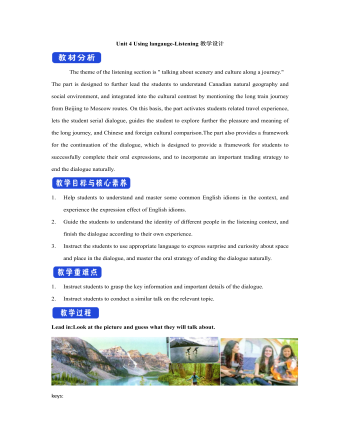
新人教版高中英语选修2Unit 4 Using langauge-Listening教学设计
The theme of the listening section is " talking about scenery and culture along a journey."The part is designed to further lead the students to understand Canadian natural geography and social environment, and integrated into the cultural contrast by mentioning the long train journey from Beijing to Moscow routes. On this basis, the part activates students related travel experience, lets the student serial dialogue, guides the student to explore further the pleasure and meaning of the long journey, and Chinese and foreign cultural comparison.The part also provides a framework for the continuation of the dialogue, which is designed to provide a framework for students to successfully complete their oral expressions, and to incorporate an important trading strategy to end the dialogue naturally.1. Help students to understand and master some common English idioms in the context, and experience the expression effect of English idioms.2. Guide the students to understand the identity of different people in the listening context, and finish the dialogue according to their own experience.3. Instruct the students to use appropriate language to express surprise and curiosity about space and place in the dialogue, and master the oral strategy of ending the dialogue naturally.1. Instruct students to grasp the key information and important details of the dialogue.2. Instruct students to conduct a similar talk on the relevant topic.
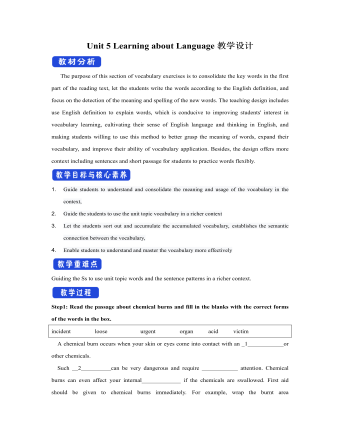
新人教版高中英语选修2Unit 5 Learning about Language教学设计
The purpose of this section of vocabulary exercises is to consolidate the key words in the first part of the reading text, let the students write the words according to the English definition, and focus on the detection of the meaning and spelling of the new words. The teaching design includes use English definition to explain words, which is conducive to improving students' interest in vocabulary learning, cultivating their sense of English language and thinking in English, and making students willing to use this method to better grasp the meaning of words, expand their vocabulary, and improve their ability of vocabulary application. Besides, the design offers more context including sentences and short passage for students to practice words flexibly.1. Guide students to understand and consolidate the meaning and usage of the vocabulary in the context, 2. Guide the students to use the unit topic vocabulary in a richer context3. Let the students sort out and accumulate the accumulated vocabulary, establishes the semantic connection between the vocabulary,4. Enable students to understand and master the vocabulary more effectivelyGuiding the Ss to use unit topic words and the sentence patterns in a richer context.Step1: Read the passage about chemical burns and fill in the blanks with the correct forms of the words in the box.
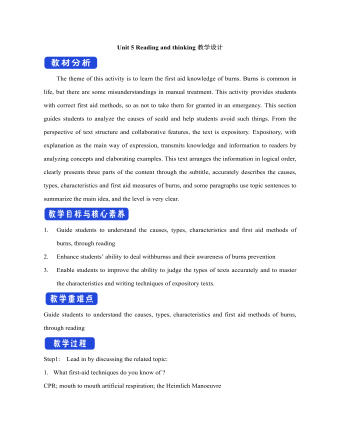
新人教版高中英语选修2Unit 5 Reading and thinking教学设计
The theme of this activity is to learn the first aid knowledge of burns. Burns is common in life, but there are some misunderstandings in manual treatment. This activity provides students with correct first aid methods, so as not to take them for granted in an emergency. This section guides students to analyze the causes of scald and help students avoid such things. From the perspective of text structure and collaborative features, the text is expository. Expository, with explanation as the main way of expression, transmits knowledge and information to readers by analyzing concepts and elaborating examples. This text arranges the information in logical order, clearly presents three parts of the content through the subtitle, accurately describes the causes, types, characteristics and first aid measures of burns, and some paragraphs use topic sentences to summarize the main idea, and the level is very clear.1. Guide students to understand the causes, types, characteristics and first aid methods of burns, through reading2. Enhance students’ ability to deal withburnss and their awareness of burns prevention3. Enable students to improve the ability to judge the types of texts accurately and to master the characteristics and writing techniques of expository texts.Guide students to understand the causes, types, characteristics and first aid methods of burns, through readingStep1: Lead in by discussing the related topic:1. What first-aid techniques do you know of ?CPR; mouth to mouth artificial respiration; the Heimlich Manoeuvre
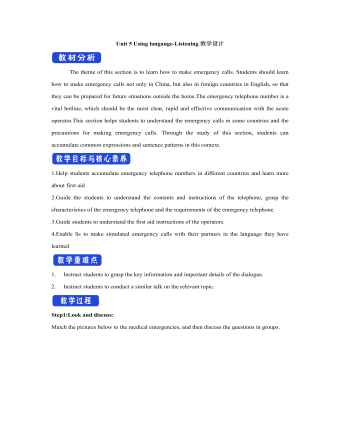
新人教版高中英语选修2Unit 5 Using langauge-Listening教学设计
The theme of this section is to learn how to make emergency calls. Students should learn how to make emergency calls not only in China, but also in foreign countries in English, so that they can be prepared for future situations outside the home.The emergency telephone number is a vital hotline, which should be the most clear, rapid and effective communication with the acute operator.This section helps students to understand the emergency calls in some countries and the precautions for making emergency calls. Through the study of this section, students can accumulate common expressions and sentence patterns in this context. 1.Help students accumulate emergency telephone numbers in different countries and learn more about first aid2.Guide the students to understand the contents and instructions of the telephone, grasp the characteristics of the emergency telephone and the requirements of the emergency telephone.3.Guide students to understand the first aid instructions of the operators.4.Enable Ss to make simulated emergency calls with their partners in the language they have learned1. Instruct students to grasp the key information and important details of the dialogue.2. Instruct students to conduct a similar talk on the relevant topic.Step1:Look and discuss:Match the pictures below to the medical emergencies, and then discuss the questions in groups.
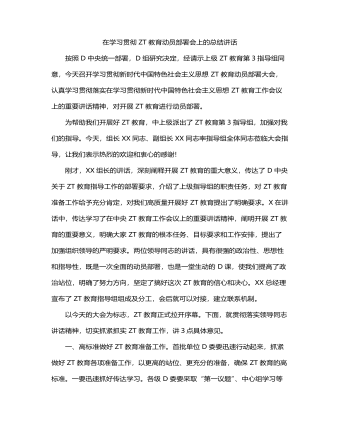
在学习贯彻主题教育动员部署会上的总结讲话
所属单位机关部门D组织ZT教育可以适当错后启动,拉开时间梯次,但也不能与上级单位间隔时间过长,最晚5月5日前要全面启动。需要强调的是,不管什么时间启动,具体到每个单位、部门,开展ZT教育的时间都不能少于5个月。无论采取哪种方式启动,都要讲清这次ZT教育的重大意义、目标要求、工作安排等。总公司机关各部门、所属各单位、各化工公司要将启动方案报巡回指导组审阅把关,巡回指导组还要现场参加指导各部门、各单位的启动工作。三、高水平进行ZT教育督促指导。强有力的督促指导是搞好ZT教育的重要保证,要把严督实导贯穿指导开展ZT教育全过程。按照D中央要求,总公司所属各单位不再派出指导组。这对总公司巡回指导组来说,担子更重了,既要直接指导所属各单位和化工公司本级D委,又要延伸指导所属单位机关部门、直属单位D组织。
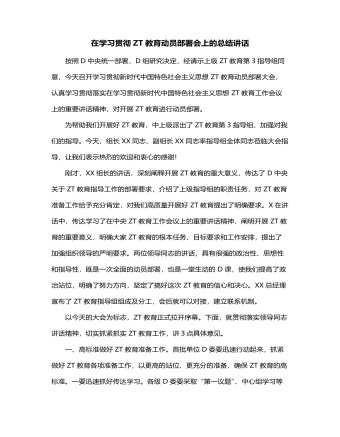
在学习贯彻主题教育动员部署会上的总结讲话
无论采取哪种方式启动,都要讲清这次ZT教育的重大意义、目标要求、工作安排等。总公司机关各部门、所属各单位、各化工公司要将启动方案报巡回指导组审阅把关,巡回指导组还要现场参加指导各部门、各单位的启动工作。三、高水平进行ZT教育督促指导。强有力的督促指导是搞好ZT教育的重要保证,要把严督实导贯穿指导开展ZT教育全过程。按照D中央要求,总公司所属各单位不再派出指导组。这对总公司巡回指导组来说,担子更重了,既要直接指导所属各单位和化工公司本级D委,又要延伸指导所属单位机关部门、直属单位D组织。要把准巡回指导工作定位,切实尊重各单位D委主体地位,紧紧依靠他们开展工作,既指出存在问题又要帮助研究对策,真正实现同题共答。
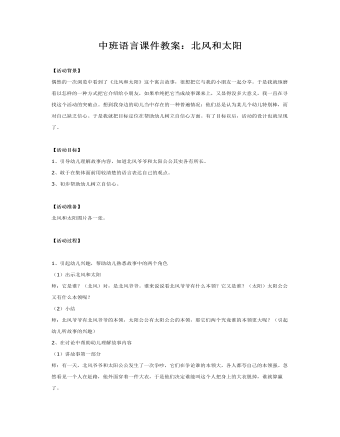
中班语言课件教案:北风和太阳
【活动目标】1、引导幼儿理解故事内容,知道北风爷爷和太阳公公其实各有所长。2、敢于在集体面前用较清楚的语言表达自己的观点。3、初步帮助幼儿树立自信心。 【活动准备】北风和太阳图片各一张。 【活动过程】 1、引起幼儿兴趣,帮助幼儿熟悉故事中的两个角色(1)出示北风和太阳师:它是谁?(北风)对,是北风爷爷。谁来说说看北风爷爷有什么本领?它又是谁?(太阳)太阳公公又有什么本领呢?(2)小结师:北风爷爷有北风爷爷的本领,太阳公公有太阳公公的本领,那它们两个究竟谁的本领更大呢?(引起幼儿听故事的兴趣)2、在讨论中帮助幼儿理解故事内容(1)讲故事第一部分师:有一天,北风爷爷和太阳公公发生了一次争吵,它们在争论谁的本领大,各人都夸自己的本领强。忽然看见一个人在赶路,他外面穿着一件大衣,于是他们决定谁能叫这个人把身上的大衣脱掉,谁就算赢了。
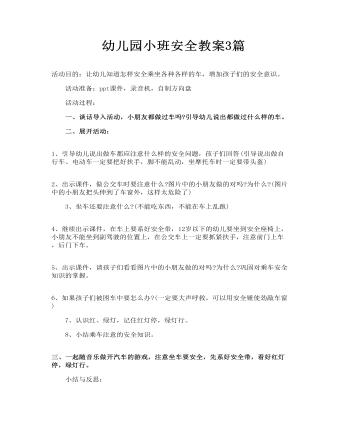
小班安全教案 幼儿园小班安全教案3篇
二、展开活动: 1、引导幼儿说出做车都应注意什么样的安全问题,孩子们回答(引导说出做自行车、电动车一定要把好扶手,脚不能乱动,坐摩托车时一定要带头盔) 2、出示课件,做公交车时要注意什么?图片中的小朋友做的对吗?为什么?(图片中的小朋友把头伸到了车窗外,这样太危险了) 3、坐车还要注意什么?(不能吃东西,不能在车上乱跑) 4、继续出示课件,在车上要系好安全带,12岁以下的幼儿要坐到安全座椅上,小朋友不能坐到副驾驶的位置上,在公交车上一定要抓紧扶手,注意前门上车,后门下车。
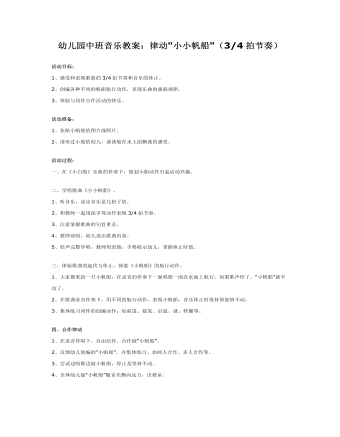
幼儿园中班音乐教案:律动小小帆船
活动准备: 1、张贴小帆船的图片或照片。 2、请坐过小船的幼儿,谈谈船在水上面飘荡的感受。活动过程: 一、在《小白船》乐曲的伴奏下,做划小船动作引起活动兴趣。二、学唱歌曲《小小帆船》。 1、听音乐,说出音乐是几拍子的。 2、和教师一起用拍手等动作表现3/4拍节奏。 3、注意掌握歌曲的句首重音。 4、教师范唱。幼儿说出歌曲内容。 5、轻声完整学唱。教师用表情,手势暗示幼儿,掌握休止时值。
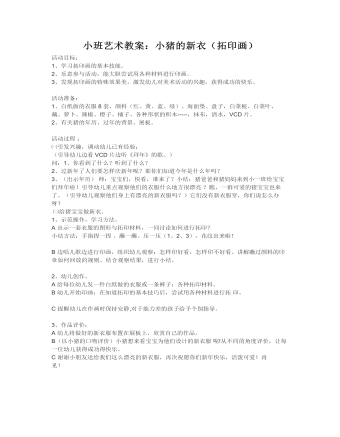
小班艺术教案:小猪的新衣(拓印画)
活动准备: 1、白纸做的衣服8套,颜料(红、黄、蓝、绿)、海面垫、盘子,白菜根、白菜叶、藕、萝卜、辣椒、橙子、橘子、各种形状的积木-----,抹布,清水,VCD片。 2、有关猪的年历、过年的背景、展板。 活动过程 : ㈠引发兴趣,调动幼儿已有经验: (引导幼儿边看VCD片边听《拜年》的歌。) 问:1、你看到了什么?听到了什么? 2、过新年了人们要怎样庆新年呢?那你们知道今年是什么年吗? 3、(出示年历) 师:宝宝们,快看,谁来了?小结:猪爸爸和猪妈妈来到小一班给宝宝们拜年啦!引导幼儿重点观察他们的衣服什么地方很漂亮 ?瞧,一群可爱的猪宝宝也来了。(引导幼儿观察他们身上有漂亮的新衣服吗?)它们没有新衣服穿,你们说怎么办呀?
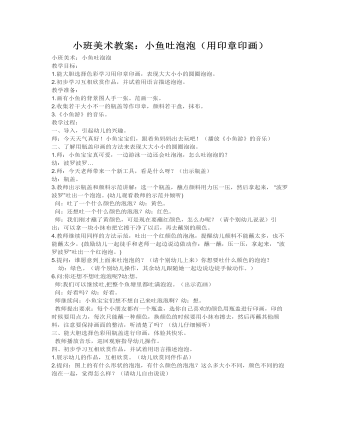
小班美术教案:小鱼吐泡泡(用印章印画)
2.初步学习互相欣赏作品,并试着用语言描述泡泡。 教学准备: 1.画有小鱼的背景图人手一张。范画一张。 2.收集若干大小不一的瓶盖等作印章,颜料若干盘,抹布。 3.《小鱼游》的音乐。 教学过程: 一、导入,引起幼儿的兴趣。 师:今天天气真好!小鱼宝宝们,跟着鱼妈妈出去玩吧!(播放《小鱼游》的音乐) 二、了解用瓶盖印画的方法来表现大大小小的圆圈泡泡。 1.师:小鱼宝宝真可爱,一边游泳一边还会吐泡泡,怎么吐泡泡的? 幼:波罗波罗… 2.师:今天老师带来一个新工具,看是什么呀?(出示瓶盖) 幼:瓶盖。
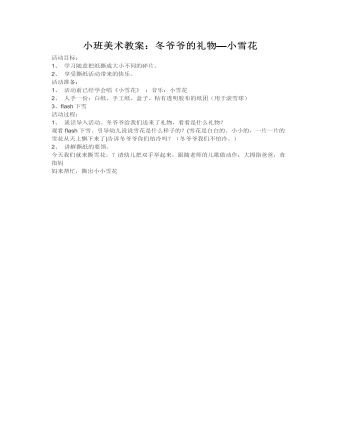
小班美术教案:冬爷爷的礼物—小雪花
2、 享受撕纸活动带来的快乐。 活动准备: 1、 活动前已经学会唱《小雪花》 ;音乐:小雪花 2、 人手一份:白纸、手工纸、盒子、粘有透明胶布的纸团(用于滚雪球) 3、flash下雪
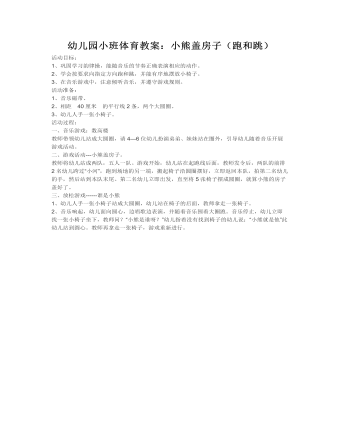
幼儿园小班体育教案:小熊盖房子(跑和跳)
2、学会按要求向指定方向跑和跳,并能有序地摆放小椅子。 3、在音乐游戏中,注意倾听音乐,并遵守游戏规则。 活动准备: 1、音乐磁带、 2、相距 40厘米 的平行线2条,两个大圆圈。 3、幼儿人手一张小椅子。 活动过程: 一、音乐游戏:数高楼 教师带领幼儿站成大圆圈,请4—6位幼儿扮演弟弟、妹妹站在圈外,引导幼儿随着音乐开展游戏活动。
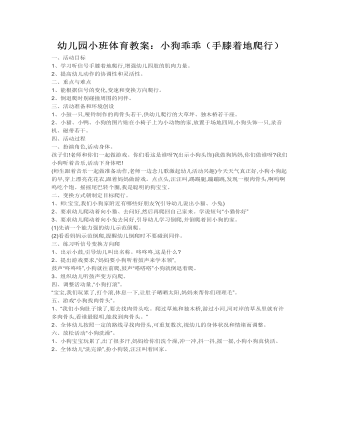
幼儿园小班体育教案:小狗乖乖(手膝着地爬行)
二、重点与难点 1、能根据信号的变化,变速和变换方向爬行。 2、倒退爬时别碰撞周围的同伴。 三、活动准备和环境创设 1、小鼓一只,哑铃制作的肉骨头若干,供幼儿爬行的大草坪、独木桥若干座。 2、小猫、小鸭、小狗的图片贴在小椅子上为小动物的家,放置于场地四周,小狗头饰一只,录音机、磁带若干。 四、活动过程 一、扮演角色,活动身体。 孩子们!老师和你们一起做游戏。你们看这是谁呀?(出示小狗头饰)我做狗妈妈,你们做谁呀?我们小狗听着音乐,活动下身体吧! (师生跟着音乐一起做准备动作,老师一边念儿歌激起幼儿活动兴趣)今天天气真正好,小狗小狗起的早,穿上漂亮花花衣,跟着妈妈做游戏。点点头,汪汪叫,踢踢腿,蹦蹦跳,发现一根肉骨头,啊呜啊呜吃个饱。摇摇尾巴转个圈,我是聪明的狗宝宝。
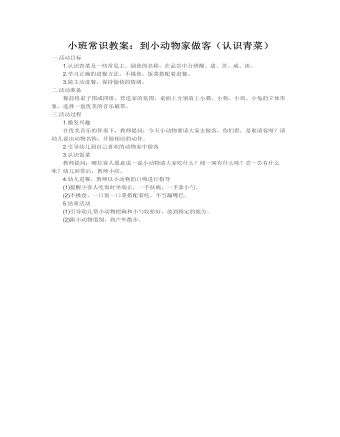
小班常识教案:到小动物家做客(认识青菜)
二.活动准备 餐前将桌子围成四组,营造家的氛围,桌面上分别放上小猫、小狗、小鸡、小兔的立体形象。选择一盘优美的音乐磁带。 三.活动过程 1.激发兴趣 在优美音乐的伴奏下,教师提问:今天小动物要请大家去做客,你们看,是谁请客呀?请幼儿说出动物名称,并做相应的动作。 2.引导幼儿到自己喜欢的动物家中做客
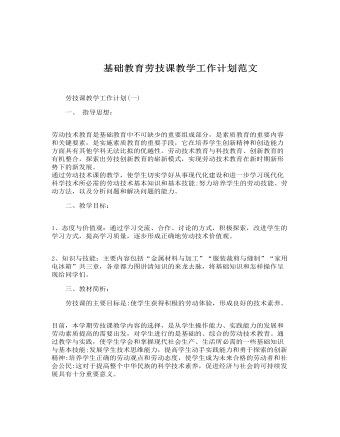
基础教育劳技课教学工作计划范文
1、态度与价值观:通过学习交流、合作、讨论的方式,积极探索,改进学生的学习方式,提高学习质量,逐步形成正确地劳动技术价值观。 2、知识与技能:主要内容包括“金属材料与加工”“服装裁剪与缝制”“家用电冰箱”共三章,各章都力图讲清知识的来龙去脉,将基础知识和怎样操作呈现给同学们。
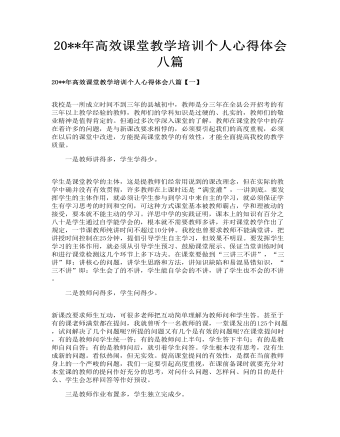
高效课堂教学培训个人心得体会八篇
一是教师讲得多,学生学得少。 学生是课堂教学的主体,这是提教师们经常用说到的课改理念,但在实际的教学中确并没有有效贯彻,许多教师在上课时还是“满堂灌”,一讲到底。要发挥学生的主体作用,就必须让学生参与到学习中来自主的学习,就必须保证学生有学习思考的时间和空间,可这种方式课堂基本被教师霸占,学和理被动的接受,要本就不能主动的学习。洋思中学的实践证明,课本上的知识有百分之八十是学生通过自学能学会的,根本就不需要教师多讲,并对课堂教学作出了规定,一节课教师纯讲时间不超过10分钟。我校也曾要求教师不能满堂讲,把讲授时间控制在25分钟,提倡引导学生自主学习,但效果不明显。要发挥学生学习的主体作用,就必须从引导学生预习、鼓励课堂展示、保证当堂训练时间和进行课堂检测这几个环节上多下功夫。在课堂要做到“三讲三不讲”,“三讲”即:讲核心的问题,讲学生思路和方法,讲知识缺陷和易混易错知识,“三不讲”即:学生会了的不讲,学生能自学会的不讲,讲了学生也不会的不讲。
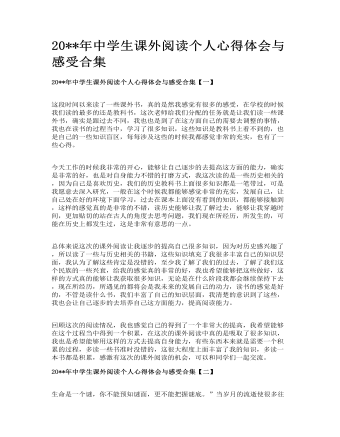
中学生课外阅读个人心得体会与感受合集
总体来说这次的课外阅读让我逐步的提高自己很多知识,因为对历史感兴趣了,所以读了一些与历史相关的书籍,这些知识填充了我很多丰富自己的知识层面,我认为了解这些肯定是没错的,至少我了解了我们的过去,了解了我们这个民族的一些兴衰,给我的感觉真的非常的好,我也希望能够把这些做好,这样的方式真的能够让我获取很多知识,无论是在什么阶段我都会继续保持下去,现在所经历,所遇见的都将会是我未来的发展自己的动力,读书的感觉是好的,不管是读什么书,我们丰富了自己的知识层面,我清楚的意识到了这些,我也会让自己逐步的去培养自己这方面能力,提高阅读能力。
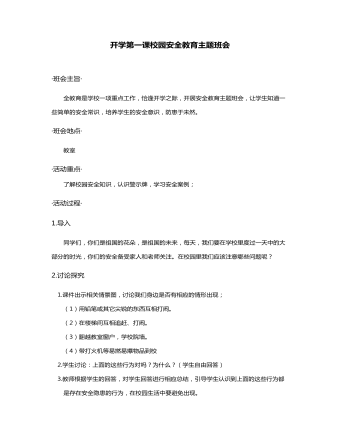
开学第一课安全教育主题班会教案
教师出示相关校园安全知识。(1)食品安全a. 不到没有卫生许可证的小摊贩处购买食品,选择新鲜和安全的食物;注意查看食品的保质期限、配方等安全信息。b. 养成良好的卫生习惯,饭前洗手。 c. 彻底洗净蔬果;不吃霉变的食物;不吃生食;尽量不吃剩菜剩饭。d. 保持健康的饮食习惯,不把饮料当水喝,不吃烧烤、油炸、烟熏及膨化食品,注意三餐定时定量。(2)人身安全 a.有序进出教室,上下楼梯靠右行,不拥挤或互相推搡。 b.在校园追跑打闹。不爬学校的围墙,门窗、围栏、树木、球架。 c.课外活动和体育锻炼,要按有关安全规则进行。在往返家校的路上,要注意交通安全,行路要严格遵守交通规则。 d.不得携带管制刀具,违禁物品进校园。(3)消防安全 a.不携带易燃、易爆、有毒物品等进入校园。 b.若插座、照明灯、电风扇等电器发生故障,不得私自动手排除,应报告教师或总务处,由学校电工进行故障排除。
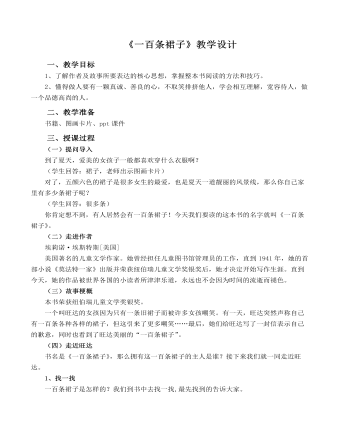
《一百条裙子》阅读课导读教案教学设计
1、书中还有许多描写旺达的片段,哪一处给你留下了深刻的印象呢?请同座位互相交流。全班交流。老师也想和大家一起分享一点感受。老师读第13页片段,并谈感受。课件出示:孤单,被嘲笑者2、你有过被人嘲笑的经历吗?谈一谈。旺达是怎样面对同学们的嘲笑?3、转学之后,十三班的同学们收到了她爸爸的来信。谁愿意读读这封信?圣诞节来临之际,旺达也写来一封信。学生读。读完这两封信,大家肯定感慨万千,一定有很多话想说吧?全班交流课件出示:善良 宽容



